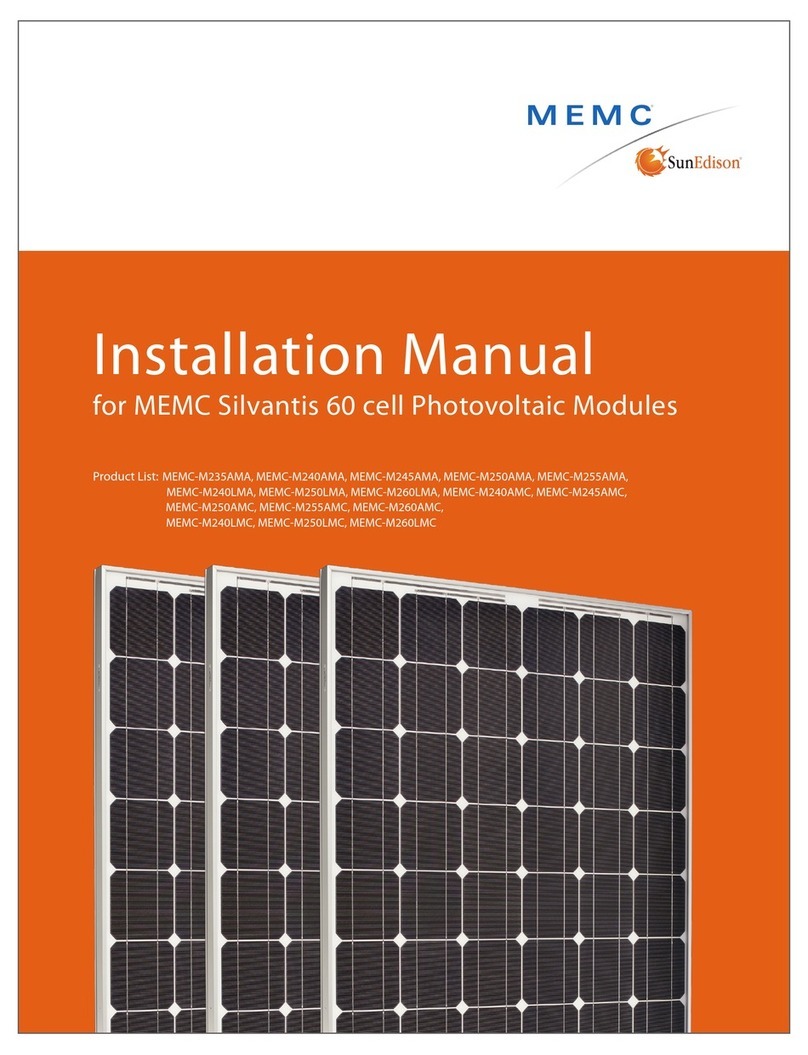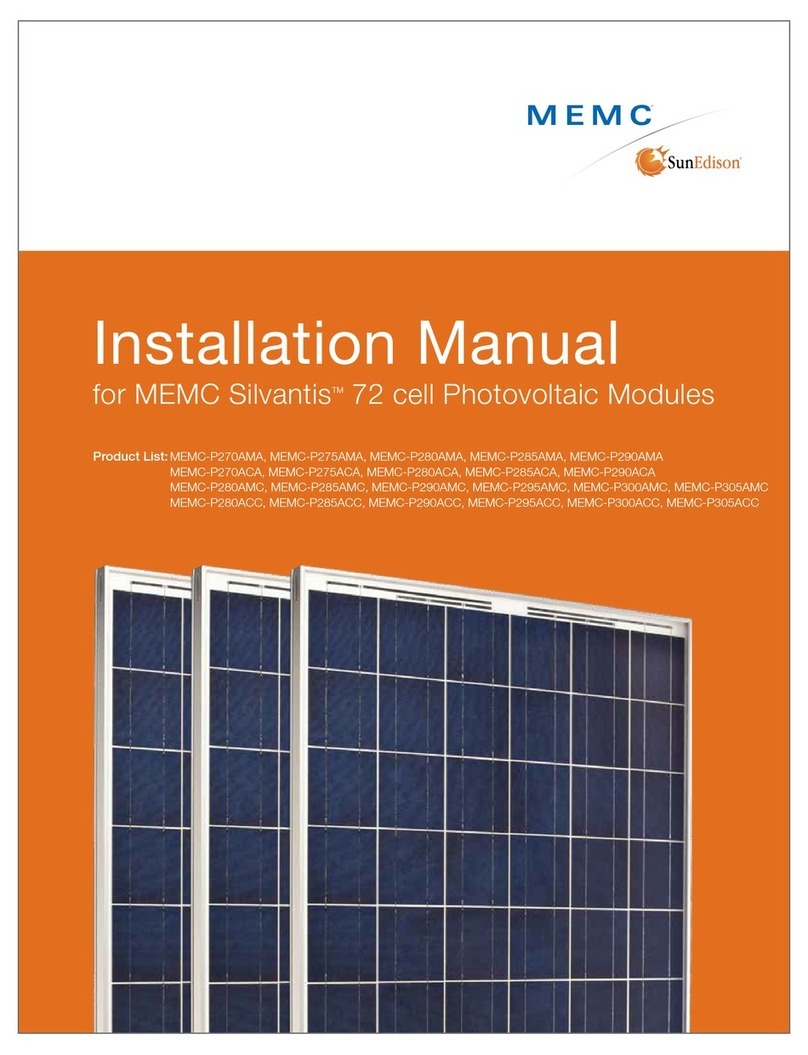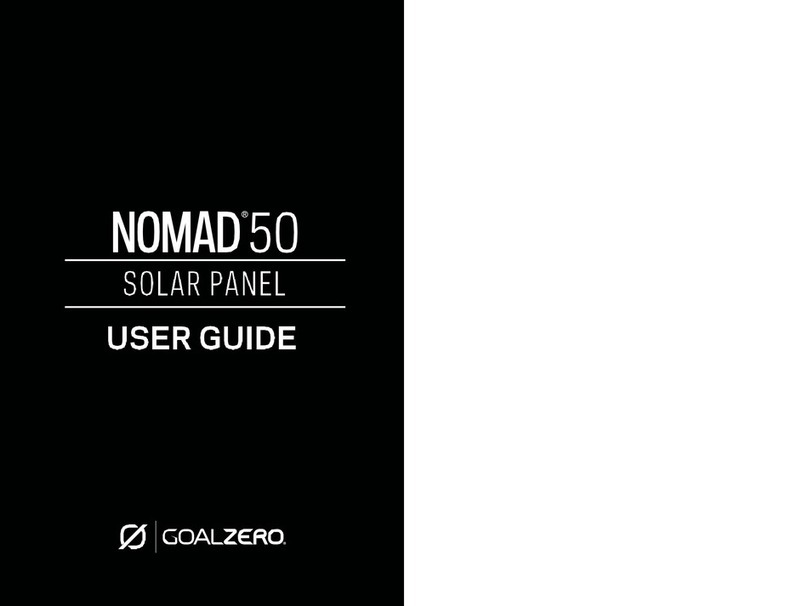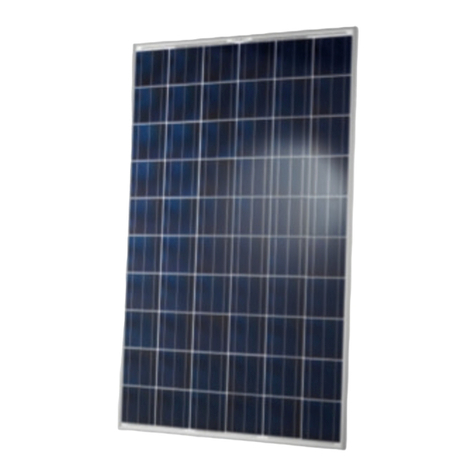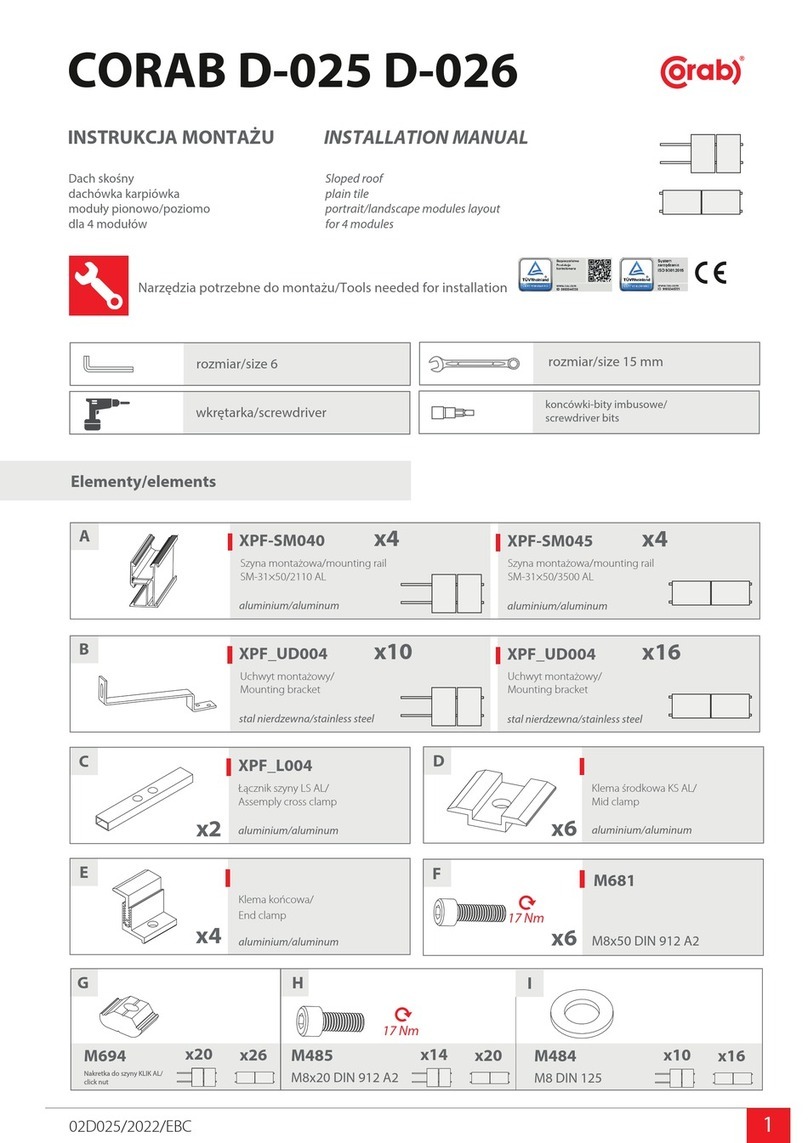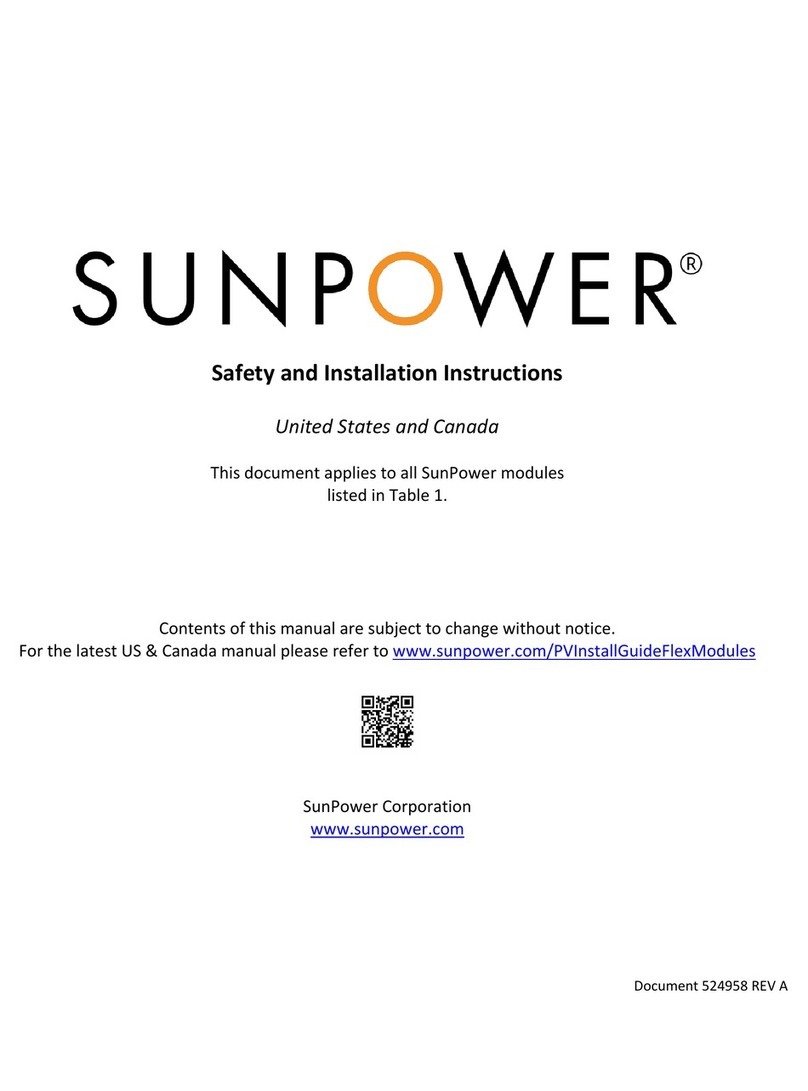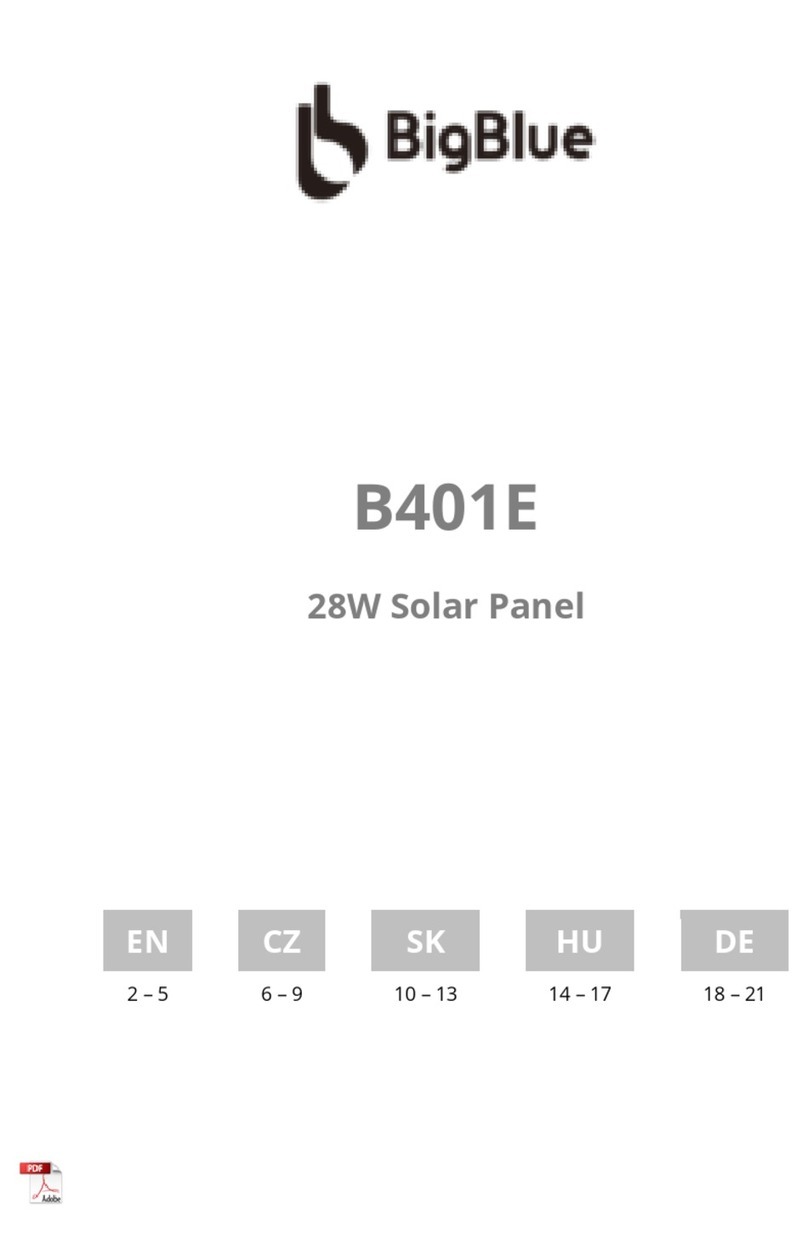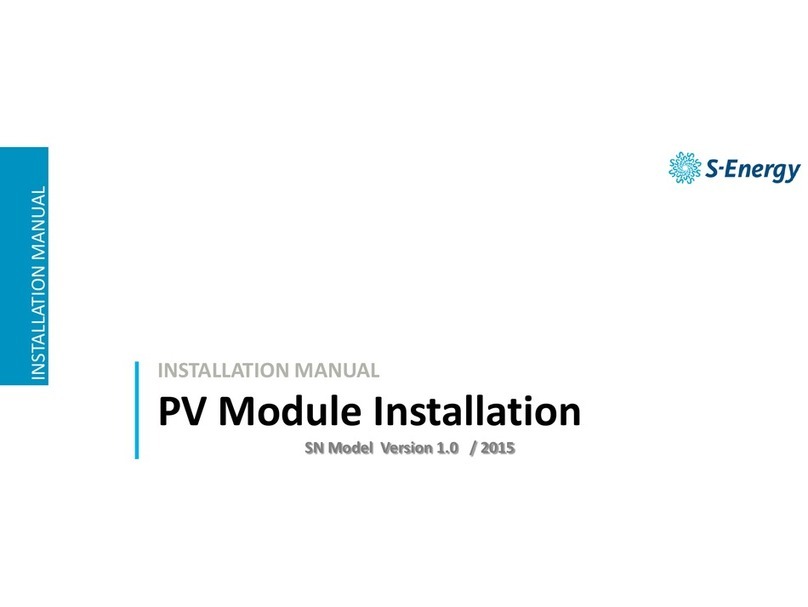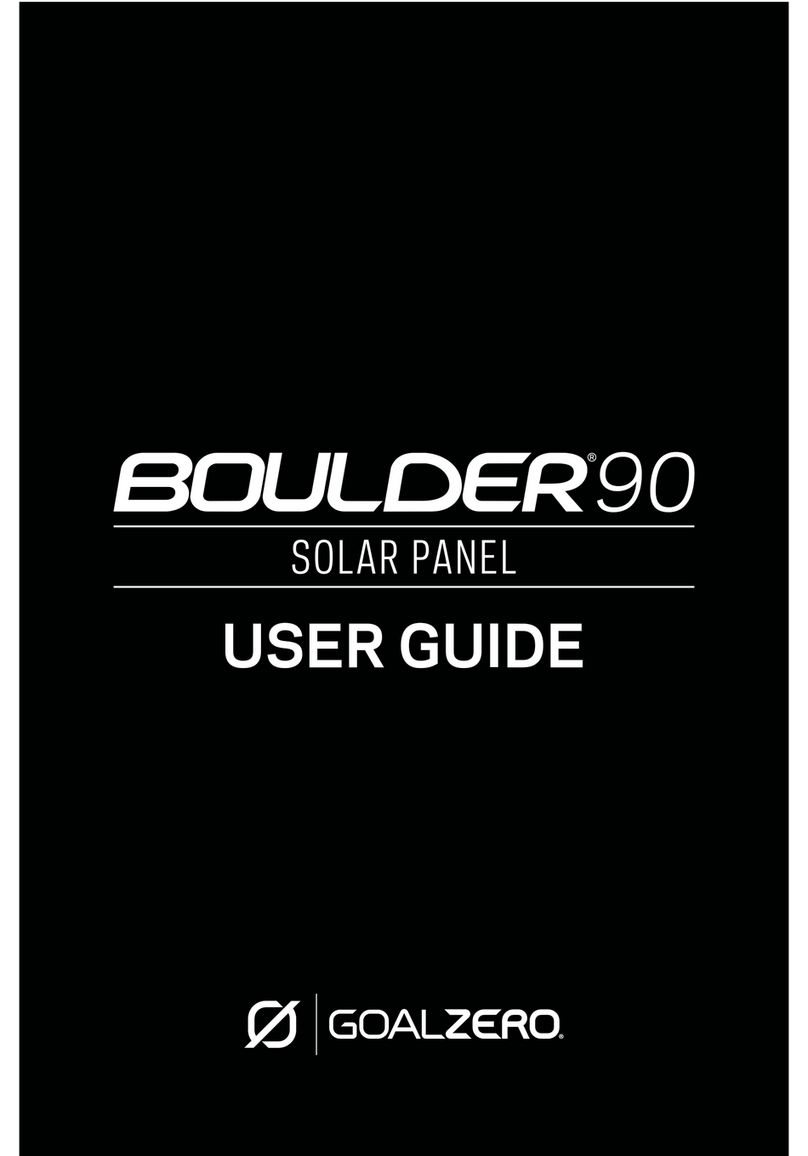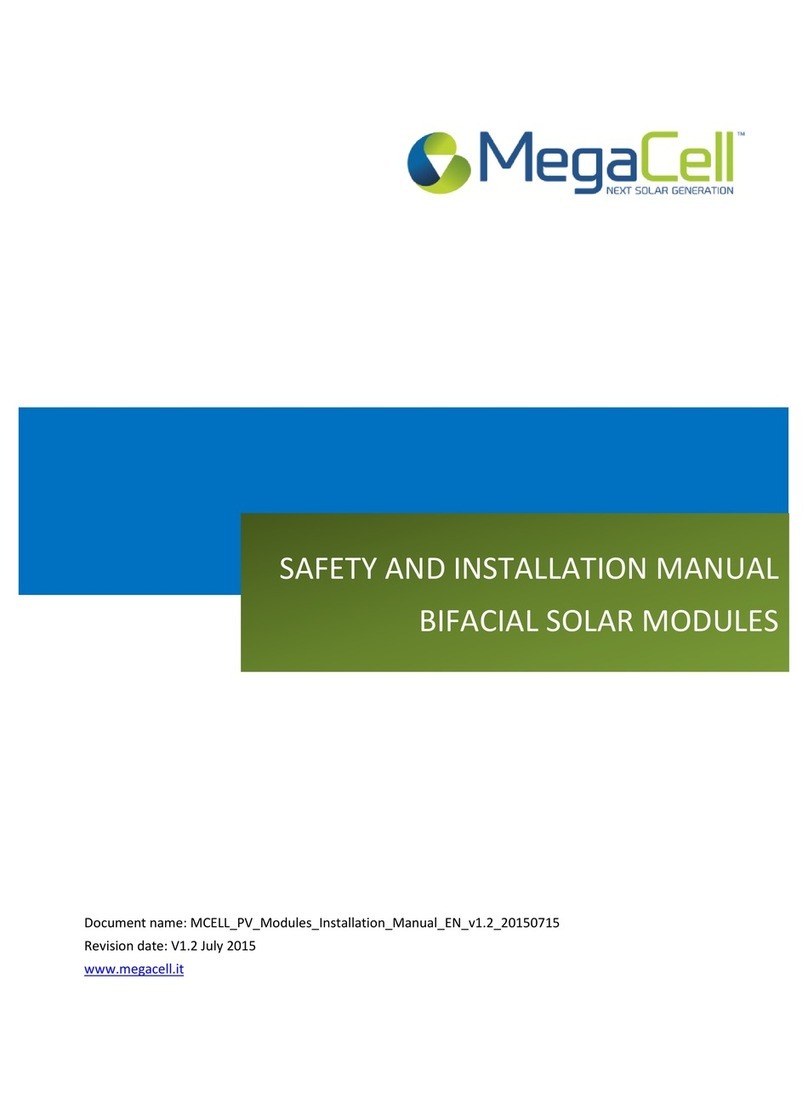MEMC P280BCC User manual

Installation Manual
for MEMC SilvantisTM 72-cell Photovoltaic Modules
Silvantis P290 Silvantis M320

Table of Contents
1.0 INTRODUCTION............................................................................................................................. 2
2.0 PHOTOVOLTAIC MODULES PRODUCT CODE........................................................................ 2
3.0 MODULE OVERVIEW..................................................................................................................... 2
3.1 MAINTENANCE................................................................................................................................ 2
3.2 STORAGE, UNPACKING, AND HANDLING.......................................................................................... 3
3.3 SAFETY............................................................................................................................................ 3
4.0 MECHANICAL INSTALLATION..................................................................................................... 4
4.1 PLANNING AND DESIGN................................................................................................................... 4
4.2 MODULE INSTALLATION OPTIONS.................................................................................................... 4
4.3 MODULE INSTALLATION USING CENTER MOUNTING BRACKETS...................................................... 4
4.4 MECHANICAL INSTALLATION WARNINGS......................................................................................... 4
5.0 ELECTRICAL INSTALLATION....................................................................................................... 6
5.1 PLANNING AND DESIGN.................................................................................................................. 6
5.2 MODULE WIRING............................................................................................................................. 6
5.3 GROUNDING................................................................................................................................... 7
5.4 ELECTRICAL INSTALLATION WARNINGS........................................................................................... 7
6.0 DISCLAIMER OF LIABILITY......................................................................................................... 8
7.0 MECHANICAL AND ELECTRICAL PARAMETERS AND SPECIFICATIONS......................... 9
8.0 APPENDIX..................................................................................................................................... 11
8.1 MODULE DETAILS.............................................................................................................................. 11
8.2 MODULE ILLUSTRATIONS................................................................................................................... 12
8.3 CLAMP DRAWINGS........................................................................................................................ 12
8.4 PRE-MOUNTED CABLES AND CONNECTORS.................................................................................. 13
© Copyright 2012 MEMC Electronic Material
Installation Manual: MEMC Silvantis P290 | M320
Customer Service
MEMC Singapore PTE. LTD.
11 Lorong 3 Toa Payoh
Block B Jackson Square 4th Floor
Singapore 319579
Fax: (65) 6681-9301
Website: www.sunedison.com
1 of 13

1.0 INTRODUCTION
The purpose of this guide is to provide general information regarding the proper installation and handling of MEMC photovoltaic
modules that serve residential, commercial, and industrial segments. System design, construction, and commissioning should be
performed by qualified personnel only.
To ensure system integrity, designers, installers and operators must meet all mechanical and electrical requirements for the system
and its components. It is the responsibility of the system designer and installer to ensure that all codes and requirements are followed
as well.
Please review all the sections that pertain to proper installation of modules listed in this Guide. The instructions detailed in this guide
must be followed throughout the module’s lifetime deployment. If you need additional information about the safe, proper use and
handling of MEMC photovoltaic module products, please contact MEMC.
2.0 PHOTOVOLTAIC MODULES PRODUCT CODE
3.0 MODULE OVERVIEW
MEMC Silvantis Photovoltaic modules consist of a series of electrically interconnected crystalline silicon solar cells that are sealed
within a laminated sheet of tempered glass superstrate* and EVA/back-sheet substrate. These laminates are secured inside an
aluminum frame to provide rigidity and a means for attachment to mounting sub-structures. The frames should not be modified or
removed. * Tempered glass may have AR coating.
• Photovoltaic modules are designed and constructed for outdoor use. Do not submerge modules in water at any time.
• The front and back of each module is labeled with a product bar code. Do not cover, remove or deface these labels. This may
be required for product identification.
• Damage to the glass surface or the anti-reflective coating can impact the power output and overall efficiency of the system.
Scratches, handling marks, or any damage to the glass surface must be avoided.
• For best performance and to avoid potential issues, keep the front side of the module clean and free of obstructions including
covers, tape, adhesives, paint and debris.
3.1 MAINTENANCE
Check modules, glass, and frames for damage. Regularly inspect all MEMC Solar Modules for safe electrical connections, sound
mechanical connections, and freedom from shading and corrosion. If dirt or debris buildup becomes excessive, periodically clean the
glass only with a soft cloth using mild, non-abrasive detergent and water. When using mild cleaning liquids, a neutral pH in the range
of 6.0 to 8.0 is recommended. Chemicals with pH less than 6.0 or greater than 8.0 should be avoided as it may damage the glass
surface and or the AR coating. Please consult with system designer to decide the cleaning and inspection frequency according to
local environmental conditions.
Do not power wash or use harsh cleaning materials or objects such as scouring powder, steel wool, scrapers, blades, or other sharp
instruments to clean the glass surface of the module. Use of such materials will invalidate the product warranty.
WARNING: Use caution when cleaning the back surface of the module to avoid penetrating the substrate materials.
Installation Manual: MEMC Silvantis P290 | M320
© Copyright 2012 MEMC Electronic Material
2 of 13
P280BCC P285BCC P290BCC P295BCC P300BCC P305BCC
P280BMC P285BMC P290BMC P295BMC P300BMC P305BMC
SilvantisTM P290
Multi-crystalline Modules
M305BCC M310BCC M315BCC M320BCC M325BCC M330BCC
M305BMC M310BMC M315BMC M320BMC M325BMC M330BMC
SilvantisTM M320
Mono-crystalline Modules

3.2 STORAGE, UNPACKING, AND HANDLING
• Packaged modules must be stored in a dry and ventilated area.
• Packaged modules must not be exposed to rain, snow, hail or other environmental conditions that may compromise the
packaging material and the modules.
• Packaged modules must be on appropriate provided pallets and must not be stacked more than two pallet high for storage.
• Once the modules are opened, store modules in a dry and ventilated room.
• Modules should never be stored in a wet environment.
• Upon unpacking, do not carry a module by its wires or junction box. Only carry a module by its frame with two or more
people.
• Precaution should be taken to avoid damage to the glass surface with or without anti-reflective coating due to improper
handling during storage or unpacking.
• Keep all electrical contacts clean and dry.
• All modules are manufactured with a sealed junction box and pre-attached cables and locking connectors. These
components should not be modified or tampered with in any way.
• Do not allow unauthorized persons near the installation site or storage area of modules.
• Do not place modules on top of one another.
• Do not place any load on the module or twist the module frame.
• Do not stand, step, walk, or jump on the module.
• Do not drop or place objects on the modules such as tools.
• Do not handle modules with bare hands and avoid scratches, handling marks, or any damage especially to the front glass of
the module, backsheet, or electrical components.
• Do not mark the modules with sharp instruments.
• Do not leave a module unsupported or unsecured.
• Do not modify module frames in any way.
3.3 SAFETY
The following safety guidelines and best practices should be followed:
• All installations must be performed in compliance with all applicable regional and local electrical codes or other national or
international electrical standards.
• Use insulated tools during installation, troubleshooting and maintenance of photovoltaic modules.
• Wear suitable protection to prevent direct contact with module’s electrical output and mechanical sharp edges.
• Cover the front of the modules with an opaque material to stop production of electricity when installing or working with a
module or wiring.
• Modules connected in a series should not be disconnected under illumination. Disconnecting modules under illumination may
cause electrical arcing which may result in burns, fires or other problems.
• Follow industry best practices when commissioning, trouble shooting, disconnecting, or connecting a PV system.
• Trouble shooting should include planning, checking, disconnecting, cause seeking, replacement, and record keeping.
• Do not install or handle the modules or their components when they are wet or during periods of high wind.
• Do not attempt to disassemble, repair, or open any part of the module including junction box or sub-components.
• Do not artificially concentrate sunlight on a module.
• Do not install or handle any broken modules. If a module is broken, or the back sheet is torn, contact with the surface or
frame can cause an electrical shock.
Installation Manual: MEMC Silvantis P290 | M320
© Copyright 2012 MEMC Electronic Material
3 of 13

• Do not wear rings, jewelry, watches, or other metallic items while working with photovoltaic modules.
4.0 MECHANICAL INSTALLATION
4.1 PLANNING AND DESIGN
• Before installation, check to ensure all sub-structure will accommodate expected system loads. This includes and is not
limited to roof, foundations, mechanical structure, and mechanical connections.
• For roof installations, utilize a fire-resistant roof covering rated for the application.
• Mechanical structures should not contact the module backsheet under any expected load conditions
• Consider the following factors during system design, which will influence performance:
a) MEMC solar modules produce the most power when they are pointed directly at the sun, and should be tilted for
optimum system performance.
b) Proximity to obstructions such as: walls, buildings, trees, groundcover, snow cover, or dust and debris that have the
potential to shade or damage the modules.
c) Elevated temperatures will decrease energy yield, so designs should ensure adequate airflow across the back of the module.
d) Allow a minimum spacing of 10 mm between modules for thermal expansion.
4.2 MODULE INSTALLATION OPTIONS FOR MOUNTING LOCATIONS
For mounting locations for clamps or bolt for specified load, please refer to Table on page 5.
• Each module should be mounted using four bolts through the mounting holes on the rear side of the module, or with four
clamps over the front side.
• Depending on the desired load capability of the array, modules may be mounted either perpendicular or parallel to the
structure rails. Clamps can be mounted anywhere inside of the safe mounting range for each case illustrated below (referring
to chart showing clamp and bolt mounting locations).
• If using bolts, four mounting holes are provided on the rear side the module frame as shown in Appendix 8.1. Use a stainless
steel bolt stack no smaller than ¼"-20 or M6, with two flat washers and a locking washer as shown in Appendix 8.2.
• To ensure an adequate clamping area, all clamps used must comply with the minimum clamping dimensions specified in
Appendix 8.3. All fasteners used to fix the modules with clamps should be stainless steel, and no smaller than ¼”-20 or M6.
• To provide adequate fixing or clamping force, torque the minimum recommended fasteners to 6.2 - 8.9 Nm (4.6 - 6.6 ft-lb).
• For all cases, the area of the supporting structure in contact with rear side of the module must comply with the minimum
support dimensions specified in Appendix 8.3.
• All other structural dimensions, such as clamp and rail thickness, should be sized appropriately for the intended site load.
4.3 MODULE INSTALLATION USING CENTER MOUNTING BRACKETS
• Modules may also be mounted using center clamps as shown in Appendix 8.2, for use with trackers.
• Module clamps for center mounting must be based on MEMC approved extrusion and hardware.
• For module loads higher than 2400 Pa, module clamps and hardware must be pre-approved by MEMC.
4.4 MECHANICAL INSTALLATION WARNINGS
• Installation and maintenance should be performed by qualified personnel only.
• Use insulated tools during installation, troubleshooting and maintenance of photovoltaic modules.
• Installers should adhere to all applicable local, regional, and national codes and regulations when designing and constructing
the photovoltaic system.
• Do not stand or walk on any surface of the modules. Do not place any objects or load on the surface of the modules.
Installation Manual: MEMC Silvantis P290 | M320 4 of 13
© Copyright 2012 MEMC Electronic Material

CASE 3
Installation Manual: MEMC Silvantis P290 | M320
© Copyright 2012 MEMC Electronic Material
5 of 13
A
MOUNTING CONFIGURATIONS
LOAD
PARAMETERS
CASE 1
Maximum
Rear Load:
2400 Pa
or 50 psf
Maximum
Front Load:
5400 Pa
or 113 psf
Mounting Color Code: Mounting Hole Location Module Rail Fixed Clamp Mount Clamp Mount Range
• Precaution should be taken to avoid damage to the glass surface with or without anti-reflective coating due to improper
handling during installation.
• Mechanical structures should not contact the module backsheet under any expected load conditions.
A – 394 mm
B – 248 mm
C – 444 mm
Fixed Clamp Mount location:
Clamp mount allowable range:
A
Clamp Mount
Locations:
Fixed clamp
location for
5400 Pa
front load
Clamp Mount Locations:
Clamp mount allowable range
Case 3, option 1
C
FRONT VIEW
BACK VIEW
CASE 2
DETAILS
Maximum
Rear Load:
2400 Pa
or 50 psf
Maximum
Front Load:
5400 Pa
or 113 psf
Maximum
Rear Load:
2400 Pa
or 50 psf
Maximum
Front Load:
2400 Pa
or 50 psf
CASE 1: Structural rails
running perpendicular to the
length of the module should be
fixed via bolts at the mounting
holes between each long
side frame, or Clamps can be
mounted at the Fixed Clamp
Mount location as shown in
the color code key.
CASE 2: Structural rails
running parallel to the length
of the module should be fixed
via bolts at the mounting
holes on each long side
frame, or Clamps can be
mounted anywhere within
the Clamp Mount Range as
shown in the color code key.
CASE 3: Structural rails running
perpendicular to the length of
the module should be fixed via
bolts at the mounting holes
between each long side frame,
or Clamps can be mounted
anywhere within the Clamp
Mount Range as shown in the
color code key.
MODULE
ILLUSTRATION
Bolt Mount
Locations
C
BACK VIEW
FRONT VIEW
Bolt Mount
Locations
Clamp Mount
Locations:
Clamp mount
allowable
range
B
C
B
C
BACK VIEW
BACK VIEW
OR Case 3, option 2

• Additional mounting holes may not be drilled in the frame, glass or backsheet.
• Ensure that frame weep holes (see Appendix 8.1) are not obstructed by the mechanical installation.
5.0 ELECTRICAL INSTALLATION
5.1 PLANNING AND DESIGN
• All modules are manufactured with a sealed junction box and pre-attached cables and locking connectors. These
components should not be modified or tampered with in any way.
NOTE: Installers should ensure that the polarized locking connectors are from the same supplier when connected on the
same string. We do not recommend mixing polarized interlocking connectors from different manufacturers—including
connections at the inverter, combiner boxes, and modules.
• Ensure connectors are clean and dry before establishing connection.
• Ensure that all wire, fusing and disconnects are appropriately sized for the system design according to national, regional, and
local codes.
• Electrical characteristics are within plus or minus 5% of rated values for Isc, Voc, Impp and Vmp. Pmax ranges between
-0/+5W at standard test conditions (STC). However, modules will operate under conditions which may be significantly
different than STC. MEMC suggests multiplying specified ratings by a minimum of 1.25* or more when specifying the system
and balance of system components. 1.25* Refer to local codes before planning and design of the system.
• • Determine the maximum number of modules connected in series using the following formula: Ns = Vmaxs / Vocm
Where:
Nsequals the maximum modules in series
Vmaxsequals the maximum system voltage
Please refer to module data sheet for actual Vmax rating, as some models are rated for 1000 V UL and 1000 V IEC.
Vocmequals the module open circuit voltage at coldest conditions for the site (refer to local codes)
WARNING: Installers should adhere to all applicable local, regional, and national codes and regulations when designing and
constructing the photovoltaic system.
NOTE: In colder climates, it may be necessary to further reduce the maximum number of modules in series by using Vocm
at the minimum expected operating temperature.
5.2 MODULE WIRING
• The module includes wires and polarized locking connectors from the junction box on the back of the module. The wires
have sufficient length to connect to adjacent modules in either a portrait or landscape configuration. Field replacement of
connectors or cables must be avoided and it will invalidate the product warranty. Polarized locking connectors of the same
type and make are needed for all series string wiring. The maximum operating temperature of wires and connectors should
not exceed 85ºC.
WARNING: It is not recommended to mix connectors from different suppliers within the same string. This includes
connections at the inverter, combiner boxes, and modules.
• Always wire modules so that proper polarity is maintained. Avoid placing excessive tension on the cables.
• There is no limit to the maximum number of series strings that can be combined in parallel. However, when doing so, each
string must include overcurrent protection with a maximum rating of 15A. MEMC recommends the use of DC rated fuses or
overcurrent protection devices with the appropriate maximum voltage rating.
• Do not connect modules directly to a parallel bus.
• The cross-sectional area of cable and the connector type must be selected to align with the overall system design and should
Installation Manual: MEMC Silvantis P290 | M320
© Copyright 2012 MEMC Electronic Material
6 of 13

include the maximum short circuit current of the system, maximum operating temperatures, and cable run lengths.
• For field connections, use at a minimum #12 AWG/4 mm2wires insulated for a minimum of 85°C. Use copper wire only.
5.3 GROUNDING
• The module frame includes several labeled grounding holes. These holes may not be used for any other purpose.
• MEMC recommends a Burndy BGBL-4 AL lay-in lug for grounding.
• Only Negative grounding circuits (negative polarity to ground) shall be used within the array design.
• Attach the grounding lug to the frame as follows:
Step 1: Use stainless steel hardware.
Step 2: Place the grounding lug over the grounding hole on the exterior of the module frame.
Step 3: Place a star washer directly between the bottom of the grounding lug and the exterior surface of the frame.
Step 4: Place an M4 or #8-32 bolt through the lug, star washer and frame grounding hole.
Step 5: Secure the lug to the frame using a flat washer, split washer and M4 or #8-32 nut.
Step 6: Torque the bolt stack to approximately 1.5 Newton.meters (or 1.1 foot pounds) to ensure the star washer
scratches the anodized frame.
5.4 ELECTRICAL INSTALLATION WARNINGS
• Installation and maintenance should be performed by qualified personnel only.
• Use insulated tools during installation, troubleshooting and maintenance of photovoltaic modules.
• Installers should adhere to all applicable local, regional, and national codes and regulations when designing and constructing
the photovoltaic system.
• Photovoltaic modules produce DC electrical energy from light. When illuminated, each module can have a DC potential of
greater than 45 V and should be handled with care.
• Disconnecting modules under illumination may cause electrical arcing which may result in burns, fires, or other problems.
Modules connected in series should not be disconnected under illumination.
• Always use a wire management system that keeps wires and cables out of direct contact with edge surfaces which could cut
or damage the insulation. Do not allow wires to rest on the ground or roof surface.
• The module junction box should not be opened or modified in any way in the field.
• Additional grounding holes may be added only with the express written consent of MEMC. New grounding holes must be
Installation Manual: MEMC Silvantis P290 | M320
© Copyright 2012 MEMC Electronic Material
7 of 13

Installation Manual: MEMC Silvantis P290 | M320
Certification
• IEC61215 certified by TÜV SÜD to ensure long-term operation in a variety of climates
• IEC61730 certified by TÜV SÜD to ensure electrical safety
• Stringent outgoing quality acceptance criteria benchmarked to industry standards
• UL1703 listed by CSA for Canada and US
Environmental AB8 (-50°C to +40°C)
Fire Resistance Rating Class C
MEMC Modules are certified by:
© Copyright 2012 MEMC Electronic Material
8 of 13
drilled using an approved drill jig, avoiding damage to the module glass, backsheet, or other module components.
• Do not use mirrors, lenses, or other techniques to magnify or concentrate additional light on the module.
6.0 DISCLAIMER OF LIABILITY
The information in this manual is based on MEMC’s knowledge and experience and is believed to be accurate. However, all
information in this manual (without exception) including recommendations and specifications does not constitute a warranty,
expressed or implied. MEMC reserves the right to change the manual, the module, or specifications without prior notice.
The product warranty shall be VOID if handling and installation of the product does not conform to MEMC’s written installation
instructions, or if the product has been reworked, repaired or otherwise modified in a manner not previously authorized by MEMC in
writing, or if the product is installed in an environment for which it was not designed. MEMC shall not be liable for special, indirect,
consequential, contingent or incidental damages related to or arising from the installation or use of the product by purchaser under
any circumstances.
MEMC assumes no responsibility for any product application or use which is beyond MEMC’s direct control. MEMC does not
accept responsibility and expressly disclaims liability for loss, damage, or expense arising out of or in any way connected to such
installation, operation or maintenance of the product.
International Product Certifications:

Installation Manual: MEMC Silvantis P290 | M320
© Copyright 2012 MEMC Electronic Material
9 of 13
7.0 MECHANICAL AND ELECTRICAL PARAMETERS AND SPECIFICATIONS
7.1 SILVANTIS P290 DETAILS
Model #
Rated Maximum Power Pmax (W)
Open-Circuit Voltage Voc (V)
Short Circuit Current Isc (A)
Module Efficiency (%)
Max Power Point Voltage Vmpp (V)
Max Power Point Current Impp (A)
ELECTRICAL CHARACTERISTICS
All electrical data at STC: 1000W/m2, AM1.5, 25ºC
Electrical characteristics measurement tolerance is ±5% and power is -0/+5W
Nominal Operating Cell Temperature (NOCT) (°C)
Temperature Coefficient of Pmax (%/°C)
Temperature Coefficient of Voc (%/°C)
Temperature Coefficient of Isc (%/°C)
Operating Temperature (°C)
Maximum System Voltage (V)
Limiting Reverse Current (A)
Maximum Series Fuse Rating (A)
Power Range (W)
TEMPERATURE COEFFICIENTS AND PARAMETERS
Temperature coefficients may vary by ±10%
47 ± 2
-0.45
-0.33
+0.066
-40 to +85
1000 (UL & IEC)
8.40
15
-0/+5
IV CURVES AT MULTIPLE TEMPERATURES [1000 W/m2]
Current (A)
Voltage (V)
1050
0
2
4
6
8
10
15 20 25 30 35 40 45 50
15°C
25°C
35°C
45°C
MEMC-
P280BMC
280
44.0
8.60
14.3
34.7
8.08
MEMC-
P285BMC
285
44.4
8.65
14.6
34.9
8.16
MEMC-
P290BMC
290
44.7
8.71
14.8
35.4
8.20
MEMC-
P280BCC
280
44.0
8.60
14.3
34.7
8.08
MEMC-
P285BCC
285
44.4
8.65
14.6
34.9
8.16
MEMC-
P290BCC
290
44.7
8.71
14.8
35.4
8.20
MEMC-
P295BMC
295
45.1
8.95
15.1
35.7
8.26
MEMC-
P295BCC
295
45.1
8.95
15.1
35.7
8.26
MEMC-
P300BCC
300
45.3
9.00
15.4
36.0
8.34
MEMC-
P300BMC
300
45.3
9.00
15.4
36.0
8.34
MEMC-
P305BMC
305
45.4
9.05
15.6
36.3
8.41
MEMC-
P305BCC
305
45.4
9.05
15.6
36.3
8.41
P280BCC P285BCC P290BCC P295BCC P300BCC P305BCC
P280BMC P285BMC P290BMC P295BMC P300BMC P305BMC
SilvantisTM P290
Multi-crystalline Modules
1000 W/m2800 W/m2
600 W/m2
400 W/m2
200 W/m2
IV CURVES AT MULTIPLE IRRADIANCES [25°C]
Current (A)
Voltage (V)
1050
0
1
2
3
4
5
6
7
8
9
15 20 25 30 35 40 45 50

Installation Manual: MEMC Silvantis P290 | M320
© Copyright 2012 MEMC Electronic Material
10 of 13
7.0 MECHANICAL AND ELECTRICAL PARAMETERS AND SPECIFICATIONS
7.1 SILVANTIS M320 DETAILS
Nominal Operating Cell Temperature (NOCT) (°C)
Temperature Coefficient of Pmax (%/°C)
Temperature Coefficient of Voc (%/°C)
Temperature Coefficient of Isc (%/°C)
Operating Temperature (°C)
Maximum System Voltage (V)
Limiting Reverse Current (A)
Maximum Series Fuse Rating (A)
Power Range (W)
48.0 ± 2
-0.46
-0.34
0.05
-40 to +85
1000 (UL & IEC)
9.10
15
-0/+5
TEMPERATURE COEFFICIENTS
AND PARAMETERS
Temperature coefficients may vary by ±10%
Model #
Rated Maximum Power Pmax (W)
Open-Circuit Voltage Voc (V)
Short Circuit Current Isc (A)
Module Efficiency (%)
Max Power Point Voltage Vmpp (V)
Max Power Point Current Impp (A)
Model #
Rated Maximum Power Pmax (W)
Open-Circuit Voltage Voc (V)
Short Circuit Current Isc (A)
Module Efficiency (%)
Maximum Power Point Voltage Vmpp (V)
Maximum Power Point Current Impp (A)
MEMC-
M305BMC
305
45.8
9.00
15.6
36.8
8.29
MEMC-
M305BCC
305
45.8
9.00
15.6
36.8
8.29
ELECTRICAL CHARACTERISTICS
ELECTRICAL CHARACTERISTICS
All electrical data at standard test conditions (STC): 1000W/m2, AM1.5, 25ºC
Electrical characteristics may vary by ±5% and power by -0/+5W
* Listed specifications are subject to change without prior notice.
All electrical data at standard test conditions (STC): 1000W/m2, AM1.5, 25ºC
Electrical characteristics may vary by ±5% and power by -0/+5W
* Listed specifications are subject to change without prior notice.
MEMC-
M310BMC
310
45.9
9.02
15.8
36.9
8.40
MEMC-
M310BCC
310
45.9
9.02
15.8
36.9
8.40
MEMC-
M315BMC
315
46.0
9.05
16.1
37.0
8.52
MEMC-
M315BCC
315
46.0
9.05
16.1
37.0
8.52
MEMC-
M320BMC
320
46.1
9.14
16.4
37.1
8.68
MEMC-
M320BCC
320
46.1
9.14
16.4
37.1
8.68
MEMC-
M325BMC
325
46.2
9.19
16.7
37.2
8.74
MEMC-
M330BMC
330
46.3
9.24
16.9
37.3
8.85
MEMC-
M325BCC
325
46.2
9.19
16.7
37.2
8.74
MEMC-
M330BCC
330
46.3
9.24
16.9
37.3
8.85
M305BCC M310BCC M315BCC M320BCC M325BCC M330BCC
M305BMC M310BMC M315BMC M320BMC M325BMC M330BMC
SilvantisTM M320
Mono-crystalline Modules
Current (A)
Voltage (V)
105 50
0
4
2
6
8
10
15 1520 25 2530 35 3540 45 4550
IV CURVES AT MULTIPLE IRRADIANCES*[25°C] IV CURVES AT MULTIPLE TEMPERATURES*[1000 W/m2]
10°C 25°C
35°C
45°C
55°C
Current (A)
Voltage (V)
100
0
2
4
6
8
10
20 30 40 50
1000 W/m2800 W/m2
600 W/m2
400 W/m2
200 W/m2

IEC 61215, IEC61730, CE, UL 1730, and Safety Class II certifications ensure that MEMC solar products operate safely and comply
with global electrical, performance, reliability, and fire safety codes.
Installation Manual: MEMC Silvantis P290 | M320
© Copyright 2012 MEMC Electronic Material
11 of 13
THE ENGINEERING DRAWING SHOWN BELONGS TO THE FOLLOWING
LISTED SILVANTIS MODULE SERIES: P290 & M320
A 990 39.0
B 1,976 77.8
C 50 2.0
D 30 1.2
E 22 0.9
Module Dimensions
Dimension MM INCH
F 950 37.4
G 1,188 46.8
H (BMC) 1,000 39.4
Mounting Hole Spacing
Dimension MM INCH
Cable Length
PHYSICAL PARAMETERS
Module Weight (kg)G 22.0
Frame Material Anodized Aluminum
Glass (mm) 3.2 Tempered ARC glass
Cable length Tolerance - 2.5 mm + 52.5 mm
Dimension tolerance range for:
A ±3 mm, B ±3 mm and C ±0.3 mm
H (BCC) 1,300 51.2

Bolt Stack Details
Center Mount Option
8.0 APPENDIX
8.2 MODULE ILLUSTRATIONS
Installation Manual: MEMC Silvantis P290 | M320
8.3 CLAMP DRAWINGS
© Copyright 2012 MEMC Electronic Material
12 of 13
A 6.35 0.3
B 38 1.5
Module Clip Dimensions
Dimension MM INCH
Minimum Support Dimensions
C 15 0.6
D 15 0.6

8.0 APPENDIX
8.4 PRE-MOUNTED CABLES AND CONNECTORS
Installation Manual: MEMC Silvantis P290 | M320
Mounting Configuration Pre-mounted cables Pre-mounted connectors
Type TUV – PV1-F & UL – PV wire locking polarized connectors
Cross section 4.0 mm² 4 mm dia.
Max. current 30 A at 85°C IEC 25 A and UL 20 A
Max. system voltage IEC 1000 V DC/ UL 1000 V IEC 1000 V DC/ UL 1000 V
Temperature rating -40°C to +90°C -40°C to +85°C
Qualification TUV 2PFG & UL PV wire EN 50521 & UL for PV sys
© Copyright 2012 MEMC Electronic Material Controlled Document - MEMC Electronic Materials, Inc. Void if Printed or Electronically
Duplicated. Information contained herein may not be revealed or disclosed to unauthorized persons or sent outside MEMC without prior
authorization. Match printed version to documentation database.
© Copyright 2012 MEMC Electronic Material
13 of 13
M320 P290 Install Guide_12 2012
This manual suits for next models
23
Table of contents
Other MEMC Solar Panel manuals
Popular Solar Panel manuals by other brands
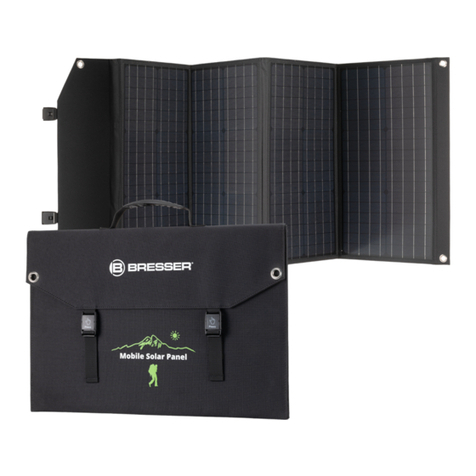
Bresser
Bresser 3810070 instruction manual
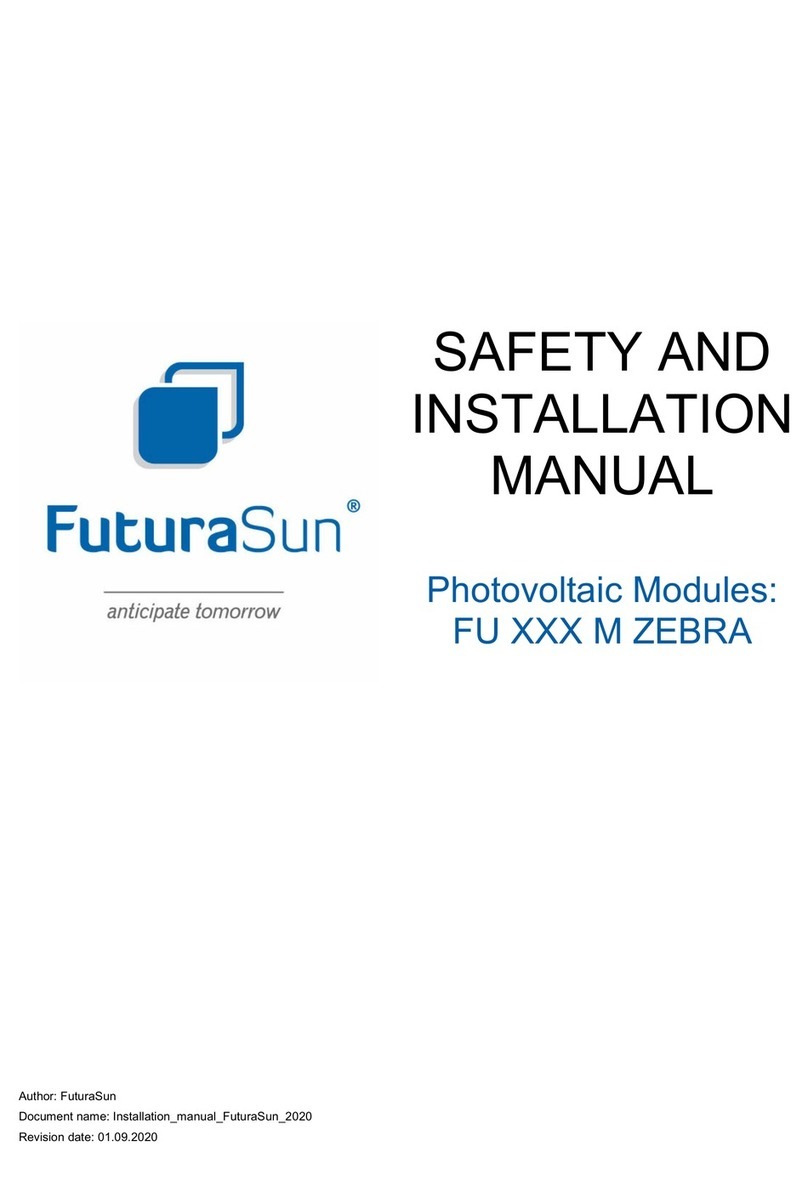
FuturaSun
FuturaSun FU M ZEBRA Series Safety and installation manual
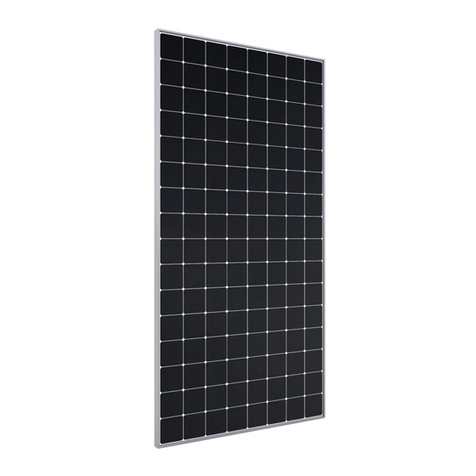
Sun Power
Sun Power E Series Safety and installation instructions

CanadianSolar
CanadianSolar Dymond CS6K-245P-FG installation manual
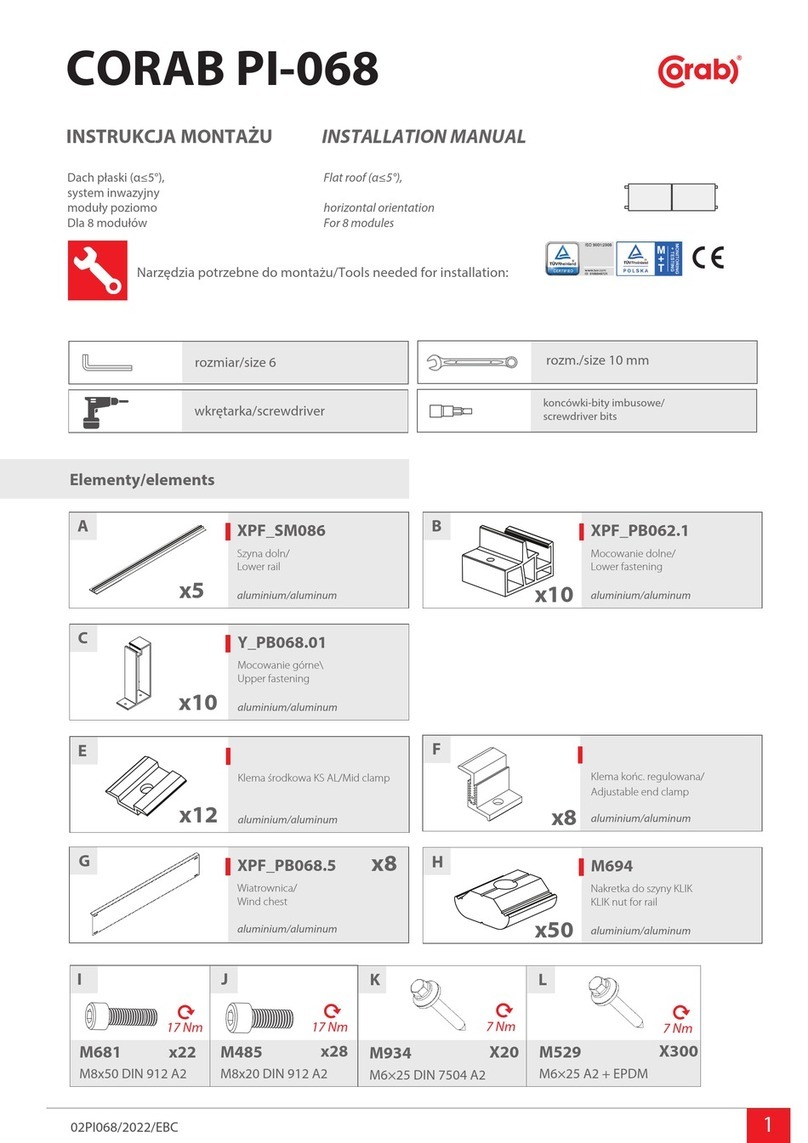
CORAB
CORAB PI-068 installation manual

CanadianSolar
CanadianSolar CS5AH-180M installation manual
